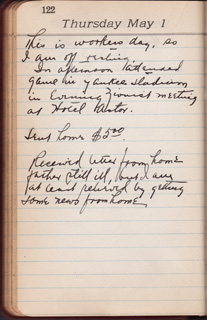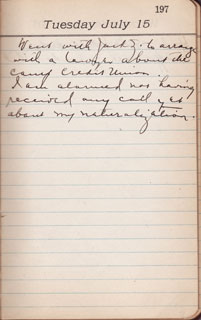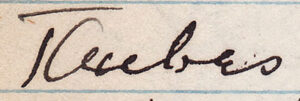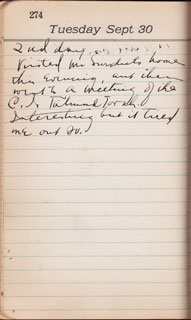
This is workers day, so
I am off resting.
In afternoon attended
game in Yankee Stadium
in Evening Zionist meeting
at Hotel Astor.
Sent home $5.00
Received letter from home
father still ill, but I am
at least relieved by getting
some news from home.
——————
Matt’s Notes
“Workers Day” refers to International Workers day or Labor Day, a holiday recognized around the world on May 1 and generally associated with the Haymarket Riot of 1886 and its tragic aftermath. (As you remember from your history lessons, the riot took place after Chicago union workers called a general strike in support of an eight-hour workday on May 1, 1886. Four days of mayhem followed. Several protesters died at the hands of the police, though events reached a tragic climax when a bomb exploded in Haymarket Square and killed at least seven police officers and four civilians. Several anarchists were falsely arrested, tried and executed for the bombing, sparking international outrage). Though the riot happened in Chicago, the United States never officially recognized May Day as a holiday, allegedly because its commemoration had quickly become associated with Socialist causes. Meanwhile, more conservative labor organizations had already prompted several states to declare the first Monday in September as Labor Day, and in 1887 Grover Cleveland decided to make it a national holiday.
Papa’s union and employer obviously still recognized May Day as a workers’ holiday in 1924; the New York Yankees, on the other hand, could only wish they had the day off, as they saw their long winning streak come to an end at the hands of the Washington Senators. Papa saw them strand runners on base all day in the course of the 3-2 loss at the Stadium, or, as the New York Times put it, “When a single or a fly meant a run or more, the Yankee hitsmiths struck out or popped out or rolled out in a manner agonizing.”

It looks like the U.S. Postal Service was open that day as well, since, my sources tell me, post offices often served as banks through which immigrants would send money overseas (I can’t be totally sure that Papa sent his $5.00 home through the post office since he had other options as well, but it’s a safe bet). Having received an update from the old country and sent some money to his family, I expect Papa was able to concentrate on his Zionist meeting at the Astor with something like a clear head.

—————
References:
- “1886 Haymarket Riot” at the Chicago Public Library Web site
- “The Legacy of Labor Day” by Richard Berman at SFGate.com
- May Day entry at Wikipedia
- The 1924 New York Yankees at baseball-almanac.com
- The 1924 Washington Senators at baseball-reference.com
————–
Image sources:
- Yankee Stadium, 4/3/23. Library of Congress # LC-B2- 5958-11. No known restrictions on publication.
- Hotel Astor. Library of Congress call number HABS NY,31-NEYO,72-.












